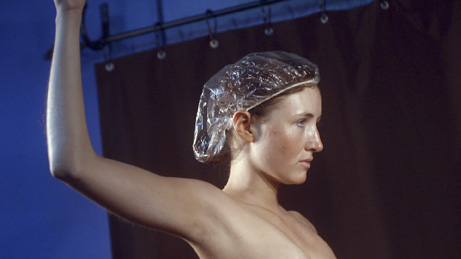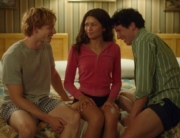It may be the role of a lifetime, but is it possible to step into the shoes of the first newsperson to commit suicide on live TV? That’s the question facing Kate Lyn Sheil, the actress cast to reenact the final days of Christine Chubbuck, a Florida TV journalist who interrupted her broadcast to shoot herself in the head. In the nearly 40 years since the infamous incident, Chubbuck has become something of an urban legend, while the actual details of her life have largely faded away. As such, the challenge of Kate Plays Christine is that there is so little to base an interpretation on.
Sheil brings a need to not merely sensationalize Chubbuck’s death but to pay respect to it. She knows that the final scene of this nonfiction/documentary experiment will require her to simulate the very act that cut the film subject’s life short, but she won’t do it unless she can successfully put herself in Chubbuck’s mental and emotional spaces. Unfortunately, little footage of the journalist exists for viewing (and the tape of the actual suicide is said to be locked away in a vault and unobtainable), and no surviving family members are available to interview. Playing amateur sleuths, Sheil and director Robert Greene turn to archived newspaper accounts, personal anecdotes, and whatever else they can get their hands on to piece together some idea of who Chubbuck was.
Their subject, they soon learn, was lonely, often butted heads with her male co-workers, and had received the devastating diagnosis that her window to have children was rapidly closing. Sheil, meanwhile, starts to transform herself physically, donning a dark-haired wig and colored contact lenses and getting a spray tan to match her subject’s bronzed skin. Yet despite the growing visual resemblance, someone points out that Sheil seems far too happy to play the suicidal depressive Chubbuck was reputed to be. For her part, Sheil continues mining for aspects of Chubbuck she can relate to, and it’s a testament to her acting ability that she convincingly grows into the skin of someone seemingly on the verge of an emotional breakdown.
At the same time as her metamorphosis, the actress also starts participating in reenactments of key scenes leading up to the subject’s fateful act. There are fights with management over the tone of her newscasts, discussions with family members who seen unable to conjure up any empathy for her, and the fateful gun purchase. Local actors play roles opposite Sheil, and at the end of a re-creation, they offer their opinions about Chubbuck’s motivations and the legacy of her very public suicide.
A recurring theme is that everyone views Chubbuck through their own highly-personalized lens. One young actress praises her for heroically showing that a woman could be deeply unfulfilled and unhappy, despite surface success. But for another interviewee, the deceased was a coward. As a result of the uncertainty surrounding exactly why Chubbuck did what she did, she becomes a kind of tabula rasa upon which complete strangers project their own feelings about life and living.
The only person who doesn’t seem to have her mind made up about Chubbuck is Sheil, whose journey to reach the emotional core of her subject eventually starts to feel like something out of a psychological thriller. The key question is: How far down into Christine can Kate fall? It seems unthinkable that she could actually follow in Chubbuck’s bloody footsteps; however, the filmmakers nudge us in that direction early on. There’s a scene in which Sheil is on the phone with her father and says offhandedly, “If a performance of mine is called ‘subtle’ one more time, I might lose my mind,” and in a voice-over soliloquy she admits that previous roles left “lingering effects” on her. Along with the possible foreshadowing, there is a palpable sense of foreboding, thanks to the use of a moody synthesizer. Meanwhile, the cinematography is frequently washed out to the extent that it has a solemn quality.
The ending does seem a little miscalculated in that it becomes more or less a rant about how the news has created generations of voyeurs hungry for blood and carnage. Not to give away the ending, but the choice Sheil and Greene make represents the actress breaking away from merely embodying Chubbuck in her final moments. Instead, she becomes her own person again, and in doing so draws her own conclusions about the worth of the subject’s life—and her death. Given how much of an enigma Chubbuck remains to the end, that’s something every viewer must do for themselves.







Leave A Comment